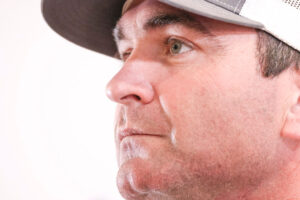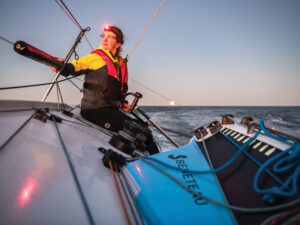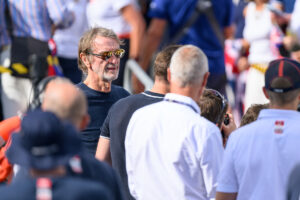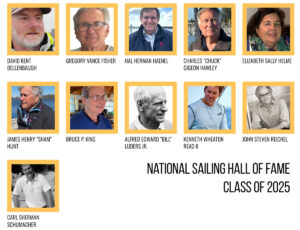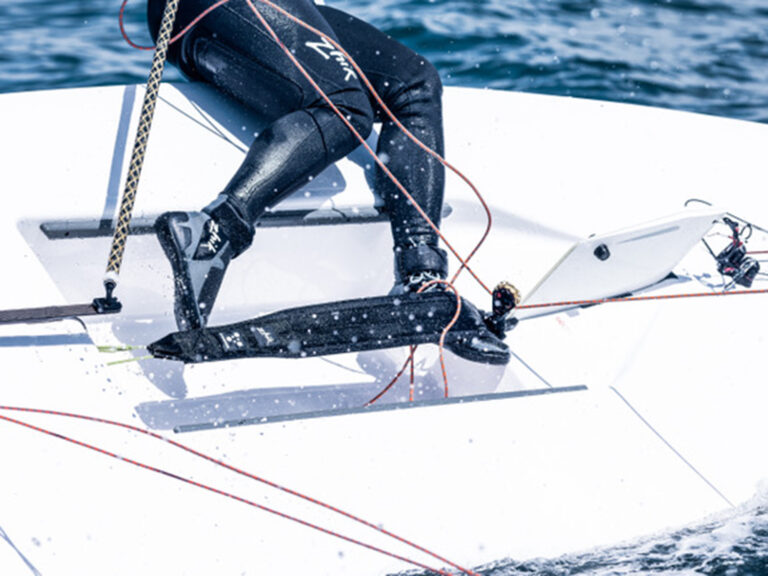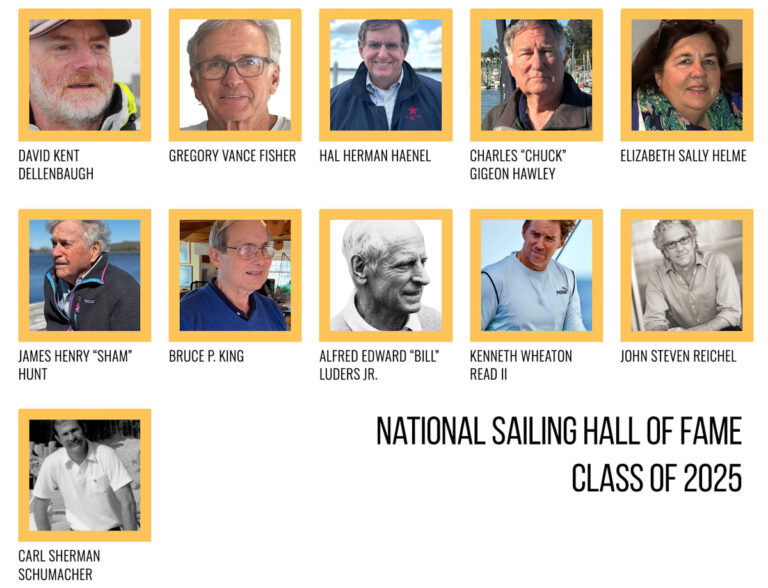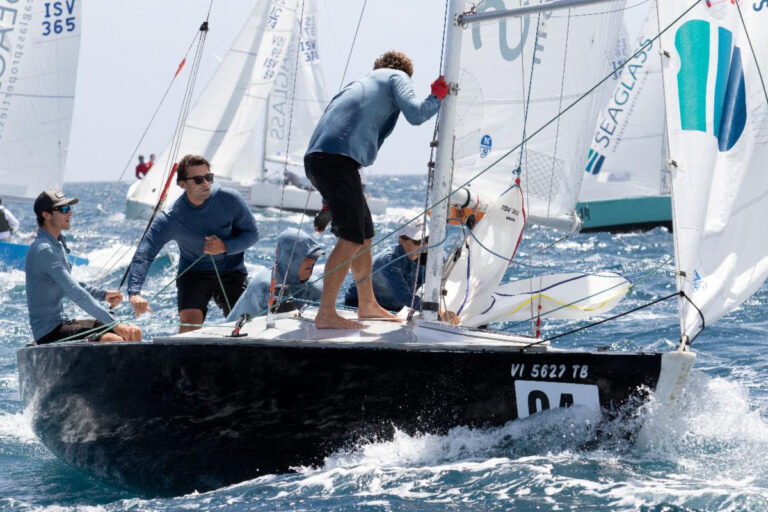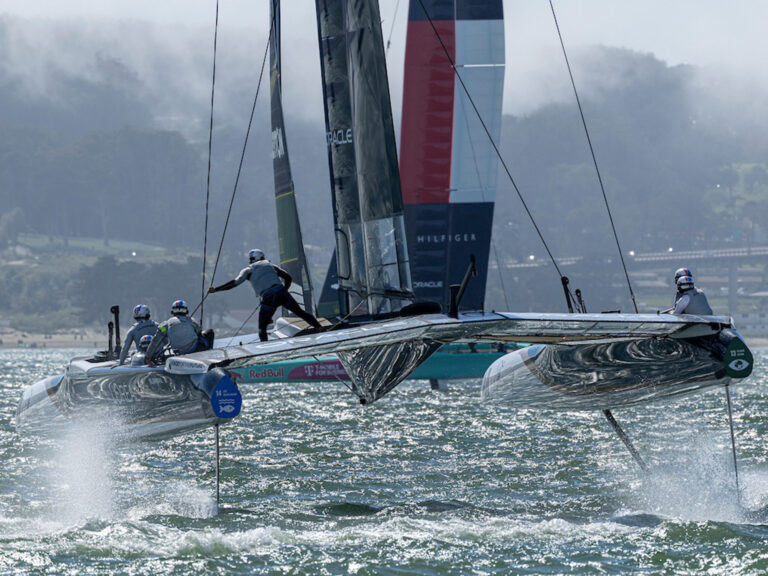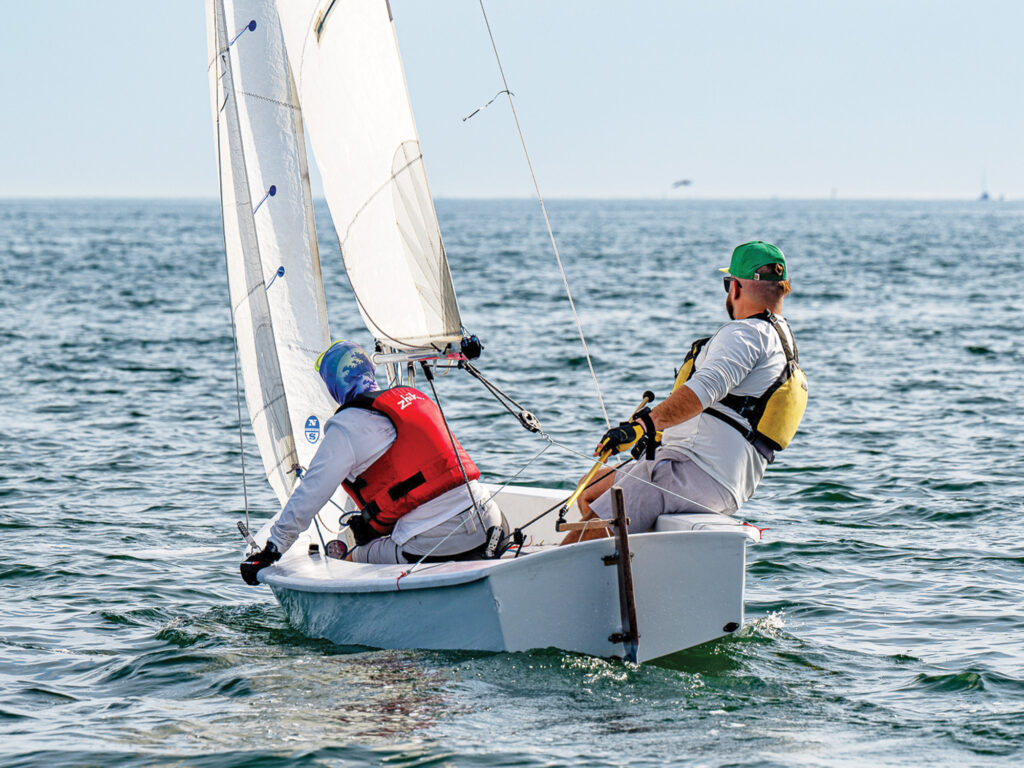
At the water’s edge on a bayside beach in downtown St. Petersburg, Florida, a vibrant orange Windmill sits in its dolly. Crisp white sails hang limp from the spars, but invisible puffs excite cassette-tape strands attached to the shrouds, foretelling what’s out yonder on Tampa Bay, a placid vastness stretching into the hazy blue horizon.
I step back and admire the angular little yacht and think, Now that’s one sweet Windmill.
The hull is polished and radiates in the morning sunshine. A closer look inside the boat reveals high-tech ropes meticulously spliced and led through micro blocks with a no-grams-spared level of perfection. Two-hundred pounds all-up, narrow, slab-sided and hard-chined, I’m told, this Windmill is an old-school reaching rocket.
This is one of eight Windmill dinghies rigged up and waiting for wind at the Helly Hansen Sailing World Regatta Series in St. Pete. Loitering under nearby palms is a tightknit clan of devotees, led by local sailor Lon Ethington. As past Windmill class president, he volunteers to give me a Windmill 101.
“It’s a planing dinghy,” he says, with a beam of smile framed by a tight white beard. “It’s just plane fun!”
Get it? And yes, that is the class motto.
Surrounding the visiting Windmills in the boat park are techie A Class Catamarans and Melges 15s, modern marvels of small-craft one-design racing. The majority of them are the same-old white look-alikes. But not the Windmills.
“Everyone has a unique color,” Ethington says. “Windmills bring the color.”
He’s been “Windmilling” for about two decades and has had a hand in dragging this ol’ one-design class into the modern age. He is both a student and professor of the boat and its improvements, and frankly, he says, there’s really nothing else to be done to make it better.
Designed by Clark Mills, creator of the Optimist Dinghy, the original plywood kit-build Windmill was envisioned to be the transition dinghy for aged-out Opti kids. But Mills missed the mark on this one. It was too much for the tykes, Ethington says, “so the adults took over.”
A change to fiberglass came soon enough, and through multiple builders over 60 years, roughly 700 Windmills have been built, 13 of them in the past five years. Class rules have been updated accordingly, Ethington says. A redesigned daggerboard and rudder make them more responsive. Full-length top battens and more-durable cloth allow Windmillers to get more seasons out of their Dacron sails.
“Because it’s quick to accelerate, the boat doesn’t wear out your equipment,” Ethington says. “Your sails last for several years because the boat is so light.”
Having the Melges 15s and Windmills in the dinghy park is a stark example of the evolution of doublehanded dinghy racing. Their shapes alone—the wide and shallow surfboardlike 15 against the narrow and tall Windmill—make them different, but the vibe is the same: The people are the energy that keeps these antique one-design classes going. To know them is to be one of them.
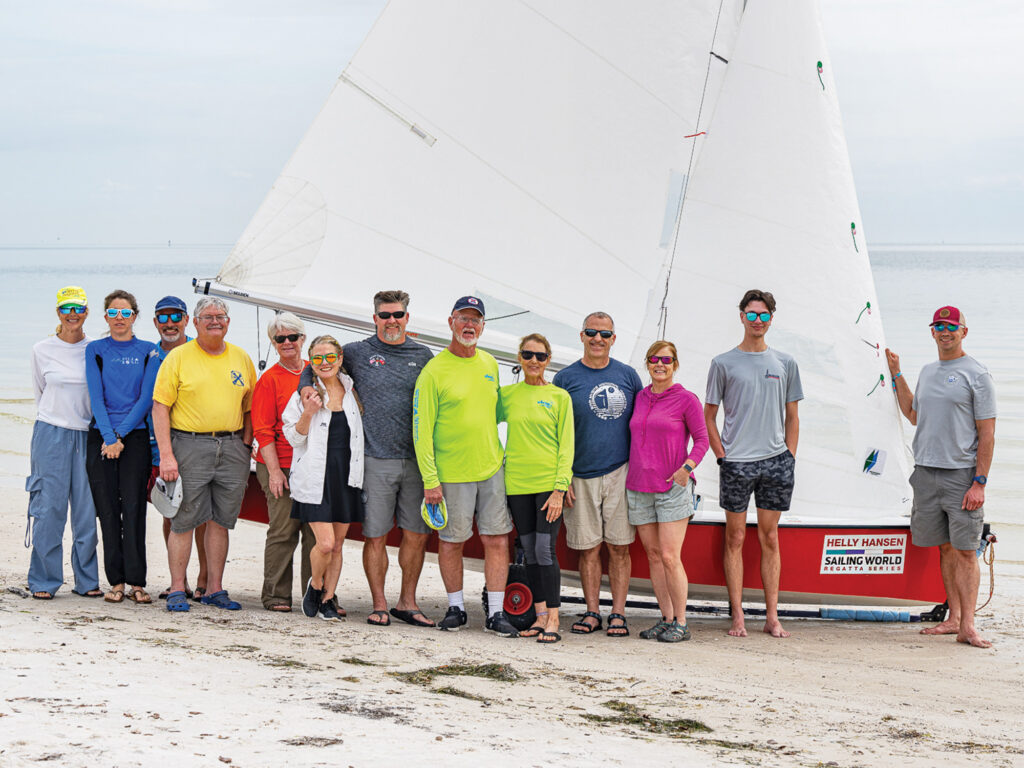
Ethington raced a J/24 for two decades, and when he started racing Windmills, he was struck by the friendly and easygoing culture of the class. Way more laid-back, it fit his style. “It’s the most civilized class I’ve sailed in,” he says. “I’ve done more than 20 [Windmill] national championships, and we’ve had two protests go to the room.”
The orange boat on the beach belongs to Pat Huntley, the 58-year-old class measurer, who hails from Pennsylvania. It is as dialed in as a Windmill can be, legally. “The dynamic in the Windmill class is that it is a really friendly group,” he says. “They don’t take themselves as seriously, but they’re tremendously good sailors.”
In fact, way back when, it was the people, not the boat, that drew him into racing Windmills. It’s a story he loves to share. Ten years ago or so, he was dating his now-wife, Janet, and they were visiting her family in Florida, where he happened upon a Windmill. “I see this goofy little boat on the front lawn of the Clearwater Sailing Center and start asking about it,” Huntley says. Long story short, the Windmills had just wrapped their Midwinters, and further inquiry led to Ethington, a longtime friend, who extended an invitation to the national championship in Columbus, Ohio.
Janet, at the time, wasn’t a sailor, but Huntley convinced her to crew for him at nationals. “I said: ‘Come on, baby. It’ll be fun.’”
She said yes, and it was all good until the wind shut down. “Janet had quickly made friends with all the girls and all the wives, and one day we’re all sitting around and waiting for the wind. She looks at me and says, ‘Hey, we’re all gonna go shopping at the mall,’ And I’m like, ‘It’s nationals—you can’t just leave. And the girls were like, ‘Yeah…we don’t really care.’ After that, she said, ‘We should buy one. These people are fun.’ And so that’s what we did right there and then.”
Ethington’s appreciation for the Windmill is its acceleration and tendency to plane easily downwind with the jib pole extended. Most of the time, the class races windward-leeward courses, but at 12 knots or more, the sailors prefer triangles. “Reaching through life…we like that,” he says with a grin, recounting his most thrilling Windmill experience.
“Once, we were sailing on the back end of a hurricane up in Long Island,” he says, “and I have no idea how fast we were going, but I was sitting on the transom of the boat, and my crew was behind the seat trying to keep the boat up. We were skipping over the top of the waves, and it was the most exhilarating feeling I’ve ever had on a sailboat.”
When he became a dues-paying member of the class, Huntley took over as measurer, mostly because “there was a lot of monkeying around with the boats.” Battling to preserve the one-design integrity meant reining in top sailors and stalwarts such as Ethan Bixby, a professional sailmaker and perennial class champion. “He’s a brilliantly fast sailor, but he’s also an International 505 guy, and those guys love to tweak. I’ve tried to keep the Windmills the other way—tight and right—so you can take my boat and go just as fast as I can.”
Working through a handful of builders over the years, some better than others, the official class molds now sit at Tartan Yachts in Painesville, Ohio, where boatbuilding icon Tim Jackett has agreed to build Windmills on demand—or rather, three boats at a time. “He has sailed mine probably four or five times,” Huntley says, “and he enjoyed the boat so much that he built one for himself.”
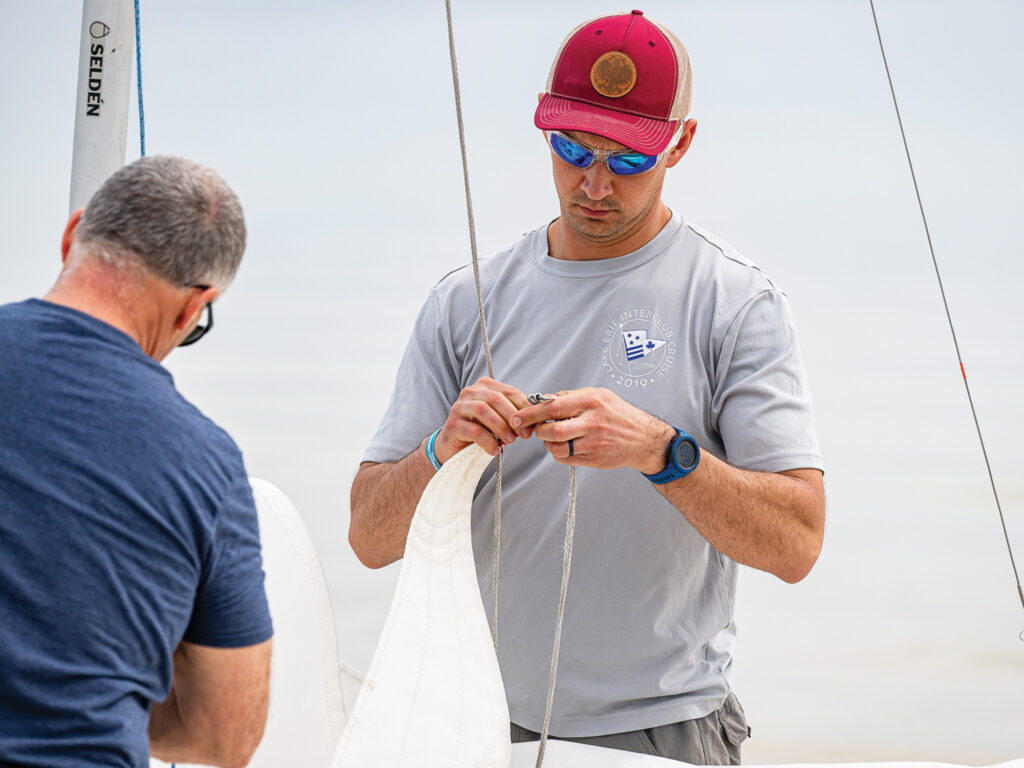
A race-ready used boat fetches anywhere from $5,000 to $6,000, and a brand new one checks out at $12,000. “We’re doing our best to make sure all the boats—new and old, glass or wood—are still competitive,” says class president Ralph Sponer, who started racing Windmills in 2009.
“We’ve tried to maintain with a builder that, yeah, we can use carbon, and we can do a lot of things to make it advance, but when we build a new boat, we have to make sure we don’t make the other half obsolete. We see in a lot of classes where there’s maybe 1,000 boats, but only 10 to 15 can really race competitively.”
Without a spinnaker, they’re plenty quick, and one key trait, Huntley says, is that the boat teaches a lot about apparent-wind sailing. The Windmill is about 100 pounds lighter than a Snipe, he says, and “while we have a similar rig as a Snipe, we basically weigh more than 100 pounds less. With that in mind, we’re sailing a lot at higher apparent-wind angles, not plowing downwind.”
With roughly five regional championships in the US, the big event is always nationals, hosted this year by the Rock Hall, Maryland, Windmill contingent. They’re aiming for 25 to 30 boats, which is the high norm these days, and this is where the class’s rock stars shine. “The competition level here is pretty high across the board,” Sponer says, but the class faces the same challenges of countless antique one-design classes.
“The biggest thing is just trying to find another generation of sailors out there,” Sponer says. “One thing we do have going for us is that we were once kind of ahead of our time, with the boat being so narrow and quick to plane.”
With roughly 90 active class members, there’s an urgency for the class to grow its ranks, which Sponer says has been the recurring challenge since taking the president’s chair nearly 10 years ago. Still, for this year’s nationals, he hopes to draw 30 boats or so. And while they now have trophies for the top 10, they also have trophies for the class’s septuagenarians, born the same year as the Windmill itself. The octogenarian trophy is forthcoming, and as far as Sponer is concerned, that’s OK.
“When I see a 70- or 80-year-old successfully sailing in all conditions, out in a narrow boat like Windmill, I have a lot of respect for that person,” he says. Because remember: “It’s just plane fun,” regardless of one’s age.

